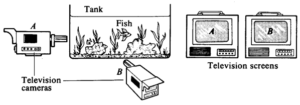In Wholeness and the Implicate Order, David Bohm presented this picture to illustrate how scientists could reconcile the incompatibilities between the theories of relativity and quantum mechanics, which he said should really be called quantum non-mechanics. For these two fundamental physical theories display opposite characteristics, the former having the properties of continuity, causality, and locality, with the latter being characterized by noncontinuity, noncausality, and nonlocality.

However, as Bohm told Danah Zohar in 1980, when she wrote a short article in a UK Sunday newspaper to announce the publication of this epoch-making book, he had not yet ‘proved’ this great synthesis mathematically. To do so, he would probably need to develop an algebra of algebras, as a non-deductive meta-algebra.
Such a universal algebra exists. But it is not obvious, lying, as it does, in the Implicate Order, deep in the Cosmic Psyche, the 99% of the Universe inaccessible to our physical senses. I call the algebra of algebras that Bohm sought Integral Relational Logic, the commonsensical system of thought and reason that we all implicitly use every day to form concepts and organize our ideas. In my case, the creative power of Life has explicated ‘unfolded’ this taxonomy of taxonomies in order to heal my fragmented mind in Wholeness.
As I describe in my post ‘Our evolutionary inheritance’, this has happened because the Logos has taken the powerful abstractions of modern algebra and the information systems modelling methods underlying the Internet to the utmost level of generality. This means that Integral Relational Logic, as a holographic universal algebra, is transcultural and transdisciplinary, not belonging to mathematics or any other academic discipline.
Rather, Integral Relational Logic provides the Cosmic Context, Gnostic Foundation, and framework or system of coordinates for Panosophy, the complete unification of all sciences and humanities, also transcultural and transdisciplinary. Thus, as a Panosopher, I transcend all the categories, following Jung‘s healing process of individuation, as an undivided being, a truly wonderful experience. For J. Krishnamurti wrote in Education and the Significance of Life, “Can any specialist experience life as a whole? Only when he ceases to be a specialist.”

But what is the fish in the tank, living in the Implicate Order, to make of all this? Well, the Sufi poet Kabir wrote in the fifteenth century, “I laugh when I hear that the fish in the water is thirsty.” Kabir is using water as a metaphor for the Ocean of Consciousness, as an extension of Bohm’s notion of the undivided holomovement, whose substance is never the same. As Bohm said, “On this stream, one may see an ever-changing pattern of vortices, ripples, waves, splashes, etc., which evidently have no independent existence as such. Rather, they are abstracted from the flowing movement, arising and vanishing in the total process of the flow.”
But this is not how astrophysicists understand our Environment, or the Arena in which we live, leaving much to be understood. For instance, Martin Rees, the Astronomer Royal in the UK, said in Our Final Century: Will the Human Race Survive the Twenty-first Century?, “In the twenty-first [century], the challenge will be to understand the arena itself, to probe the deepest nature of space and time,” going on to say, “A fish may be barely aware of the medium in which it swims.” For, as Kabir the weaver says in the fish poem, “You do not see that the Real is in your home, and you wander from forest to forest listlessly.”
A principal reason why evolution is blind is that what scientists see in the explicate order today is delusionary, inhibiting us from revealing Reality, as it is, transcending the categories, even those that lie in the Implicate Order. A major step towards such an apocalyptic revelation is being taken at The Laszlo Institute of New Paradigm Research, which is ‘Pioneering a Paradigm Shift’.
Its founder, the systems philosopher Ervin Laszlo, calls this great revolution in science the ‘Akashic paradigm’, using the word Akasha to refer to the Universal Quantum Field. He took the word from Vivekananda’s Raja Yoga: “Everything that has form, everything that is the result of combination, is evolved out of this Akasha. … Just as Akasha is the infinite, omnipresent material of this universe, so is this Prana the infinite, omnipresent manifesting power of this universe.”
The word Akasha derives from Sanskrit Ākāsha, corresponding to Greek aither ‘pure, fresh air’, in Latin æther, “the pure essence where the gods lived and which they breathed”, which is quintessence, the fifth element, the others being fire, air, earth, and water, of course. But what is this quintessential æther and how can we know of its existence, never mind that it is Ultimate Reality? Well, in 1887, Albert Michelson and Edward Morley showed in a famous experiment that an ‘æther wind’ could not be physically detected as the Earth passed through the supposed æther. Although Albert Einstein did not specifically mention the Michelson–Morley experiment in his 1905 paper on the special theory of relativity, he did say that the notion of ‘aether-drift’ is ‘superfluous’ in his theory.

Even though we cannot access Ultimate Reality through our physical senses, throughout the ages, we humans have sensed an immanent, transcendent Presence, etymologically ‘before being’ or ‘prior to existence’, for Presence derives from Latin præsentia ‘presence’, participle of præesse ‘to be before’, from præ ‘before’ and esse ‘to be’. The word Presence indicates that the Absolute is the Supreme Cause of Everything there is, which mystics through the ages have sought to reveal. For instance, in the fifth or sixth century, Pseudo-Dionysius the Areopagite, writing in Greek, wrote these beautiful words, which resonate deep within my being:
Again, as we climb higher we say this. It is not soul or mind, nor does it possess imagination, conviction, speech, or understanding. Nor is it speech per se, understanding per se. It cannot be spoken of and it cannot be grasped by understanding. It is not number or order, greatness or smallness, equality or inequality, similarity or dissimilarity. It is not immovable, moving, or at rest. It has no power, it is not power, nor is it light. It does not live nor is it life. It is not a substance, nor is it eternity or time. It cannot be grasped by the understanding since it is neither knowledge nor truth. It is not kingship. It is not wisdom. It is neither one nor oneness, divinity nor goodness. Nor is it a spirit, in the sense in which we understand that term. It is not sonship or fatherhood and it is nothing known to us or to any other being. It falls neither within the predicate of nonbeing nor of being. Existing beings do not know it as it actually is and it does not know them as they are. There is no speaking of it, nor name nor knowledge of it. Darkness and light, error and truth—it is none of these. It is beyond assertion and denial. We make assertions and denials of what is next to it, but never of it, for it is both beyond every assertion, being the perfect and unique cause of all things, and, by virtue of its preeminently simple and absolute nature, free of every limitation, beyond every limitation; it is also beyond every denial.
There is no need to say anything more. When we ‘sense’ the Ineffable deep in our hearts, we have completed our spiritual journey, as the ultimate purpose of life on Earth. As the Sufi poet Rumi beautifully put it, “Love is the sea of not-being and there intellect drowns.” Similarly, John wrote in his first Epistle in the Bible, “God is Love; and he that dwelleth in Love dwelleth in God, and God in him.” And returning to the words of a scientist, Guy McPherson, a leading authority on abrupt climate change, often ends his YouTube videos with the words “On the edge of extinction, only Love remains.”




